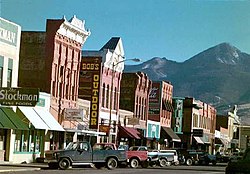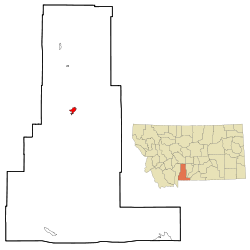Livingston, MT
| Livingston, Montana | |
|---|---|
| City | |

Downtown Livingston
|
|
 Location of Livingston, Montana |
|
| Coordinates: 45°39′32″N 110°33′49″W / 45.65889°N 110.56361°WCoordinates: 45°39′32″N 110°33′49″W / 45.65889°N 110.56361°W | |
| Country | United States |
| State | Montana |
| County | Park |
| Area | |
| • Total | 6.03 sq mi (15.62 km2) |
| • Land | 6.02 sq mi (15.59 km2) |
| • Water | 0.01 sq mi (0.03 km2) |
| Elevation | 4,501 ft (1,372 m) |
| Population (2010) | |
| • Total | 7,044 |
| • Estimate (2016) | 7,401 |
| • Density | 1,200/sq mi (450/km2) |
| Time zone | Mountain (MST) (UTC-7) |
| • Summer (DST) | MDT (UTC-6) |
| ZIP code | 59047 |
| Area code(s) | 406 |
| FIPS code | 30-43975 |
| GNIS feature ID | 0773511 |
| Website | www |
Livingston is a city and the county seat of Park County, Montana, United States. Livingston is located in southwestern Montana, on the Yellowstone River, north of Yellowstone National Park. The population was 7,044 at the 2010 census.
The founding of the small historical railroad and ranching town of Livingston, Montana is a direct result of the Northern Pacific Railway (NPR). This site became a centralized point in the Rockies and the NPR's location for railroad shops to service NPR steam trains before their ascent over the Bozeman Pass, the highest point on the line. Livingston also became the first gateway town to America's first national park, Yellowstone National Park. This is to where the NPR began promoting heavily to visitors from the East. The NPR operated a branch line running some fifty miles south through Paradise Valley to, first the Cinnabar station and later to Gardiner, Montana.
Downstream (the Yellowstone River), approximately 3 miles from present day Livingston, was where an old fisherman named Amos Benson built a log cabin in 1872. This is where a ferry, a trading post and a small community called Benson's Landing was. Across the river from Benson's Landing in June 1882 was the camp of about 40 tents of the Northern Pacific survey crew.This is where they thought that the supply store site they were looking for should be. On July 14, 1882, a man who worked for the Northern Pacific named Joseph J. McBride arrived with orders to find another site to build the store. Two days later on July 16, 1882 George H. Carver, a man who would become a major local businessman and local political leader, arrived at the site of present-day Livingston. Carver and McBride became the first local residents when they pitched their tents on the 16th. Also on the 16th arrived 30 freight wagons drawn by 140 head of oxen, carrying 140,000 lbs. of merchandise. The supply store was to be of Bruns and Kruntz, contractors. Eventually the tents gave away to log cabins. All of Benson's Landing encampment moved up the river to Carver and McBride's camp within 10 days of freight train's arrival.
This new settlement was called "Clark City" after Heman Clark, the principal contractor for the Northern Pacific from the Missouri westward. By fall the town was well established and an election poll in November 1882 counted 348 votes for delegates to congress. Clark City was on the southeast side at the East end of Lewis St. just southwest of the KPRK, and is now part of Livingston. B.F. Downen built the first permanent residence (out of wood) and Frank White owned the first saloon. Clark City eventually had 6 general stores, 2 hotels, 2 restaurants, 2 watchmakers, 2 wholesale liquor dealers, 2 meat markets, 3 blacksmiths, 1 hardware store, 30 saloons and a population of 500 people.
...
Wikipedia
